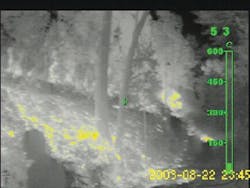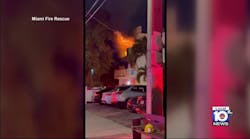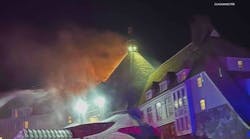With training, many years of practice and maybe just a little bit of crazy, generations of wildland firefighters have approached fires measured in acres or thousands of acres and thought, “I can do that!” They have battled fires from the air and on the ground, often in poor visibility and with limited support. Now, with the emergence of thermal imaging in wildland firefighting, working conditions on the ground and information gathering from the air can be greatly enhanced.
Used properly, thermal imagers can help crews more effectively monitor fire conditions, place personnel in key areas to create control lines, enhance safety during firefighting and improve the control of prescribed burns. Firefighters can also use thermal imagers to enhance their safety when navigating through smoke and maintain accountability even when separated by distance and poor visibility. The advent of smaller thermal imagers, longer operating times and alkaline battery packs have made the technology more applicable to wildland firefighting.
• Monitoring the flank and head of the fire from the air – With a thermal imager, the fire’s location and progress will be evident from an aerial position, regardless of daylight or smoke conditions. This enables precise monitoring of fire progress that would not otherwise be possible. Accurately sizing-up a fire lets command properly deploy resources and to make more effective stops on otherwise growing fires. Many times, the flank or head of the fire are obscured in heavy smoke, particularly in wet areas or in the presence of green fuels. With the thermal imager, accurate assessment of the fire and spread can be obtained regardless of smoke conditions. The ability to monitor fire progress in low light means crews can begin operations earlier in the day and end later in the evening, increasing efficiency.
• Placing and monitoring personnel – Especially in large operations, the placement of limited personnel is critical to gaining control. With the enhanced visibility that thermal imaging provides, firefighters can be placed in key locations where control lines must be constructed. Proper placement enhances the ability of firefighters to protect exposures, including structures, threatened habitats and critical infrastructure. As ground crews deploy, airborne supervisors can monitor their locations and ensure a coordinated and effective response. Ground and air crews can effectively deploy thermal imagers. Equipping ground crews can let them monitor fire conditions in their immediate area providing more localized, advanced warning than might otherwise be possible.
• Monitoring dangers and extinguishing hot spots on the ground – With proper training on image interpretation, firefighters can use thermal imagers to monitor fire movement on the ground and in the trees above them. The direction and volume of fire brands can be tracked and monitored with a thermal imager. With practice, firefighters can identify snags, thereby improving safety on the job. During mop up, crews with thermal imagers can scan burned areas to ensure that the fire is out and better prevent the opportunity for flare-up or rekindle.
• Managing prescribed burns – Controlled burns are critical to reducing the fuel load to improve manageability of wildland fires. Using the images on thermal imagers, firefighters involved in prescribed burning can monitor the direction of fire spread and manage mop up more effectively. This provides information that enables them to protect exposures and keep these burns in a controlled state.
• Navigation – When firefighters travel by ground during active wildland fires, their vision may be obscured by smoke. Thermal imagers used from a vehicle can assist the driver in navigating safely through thick smoke, avoiding fixed hazards as well as firefighters on foot. Firefighters on foot can use a thermal imager to help identify safer travel routes based on terrain or fire movement. This can help crews move safely and effectively when smoke obscures their vision. Thermal imagers also provide an effective means of night vision. Since a thermal imager does not register light, its picture is fairly consistent regardless of daylight conditions. This can extend firefighting operations and enhance crew safety by providing clear views of surrounding terrain and potential escape routes.
Firefighters should be aware that thermal imaging technology is not a replacement for basic tactics. For example, there may be times in mop-up when a thermal imager cannot detect a hidden heat source, such as when the heat exists deep within a tree trunk. There may also be times when the image on a thermal imager appears inconclusive to the user.
Most thermal imagers on the market today were designed to operate inside a structure. These imagers are equipped with a wide field of view so that when entering a residential room, a structural firefighter can see much of the room in one quick glance. While this is a benefit to a structural firefighter, it can serve as a detriment to a wildland firefighter.
The side effect of a wide field of view is a limitation of distance. All thermal imagers have a detection range. This typically defines the size of a heat target – three feet by three feet, for example – and a distance at which the target can be detected. While there are numerous variables to account for, understand that the farther away you are, the more likely it is that something can be missed by a thermal imager. This is not to say that you need to be within a certain distance (handheld thermal imagers are commonly used from the air); rather, you should simply practice with it and get a feel for what the technology is telling you.
Thermal imagers can be used to improve operations in a wide variety of wildland firefighting operations, from the air and on the ground. While the dangers faced by wildland firefighters are different than those faced by structural firefighters, the thermal imager is a tool that can benefit firefighters in both types of incidents. By first understanding how a thermal imager can be employed during a wildfire response, then practicing with it on a regular basis, firefighters can improve their personal safety as well as team effectiveness. Remember the 10 Standard Firefighting Orders and 18 Watch Out Situations (http://www.fs.fed.us/fire/safety/10_18/10_18.html) are the bible of wildland firefighting and thermal imagers should only be used to enhance the decision-making process.






